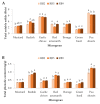Light Spectrum Differentially Affects the Yield and Phytochemical Content of Microgreen Vegetables in a Plant Factory
- PMID: 34685989
- PMCID: PMC8549008
- DOI: 10.3390/plants10102182
Light Spectrum Differentially Affects the Yield and Phytochemical Content of Microgreen Vegetables in a Plant Factory
Abstract
Light quality exerts considerable effects on crop development and phytochemical content. Moreover, crops grown as microgreens are ideal for plant factories with artificial lighting, since they contain greater amounts of bioactive compounds compared to fully-grown plants. The aim of the present study was to evaluate the effect of broad-spectra light with different red/blue ratios on the yield, morphology, and phytochemical content of seven microgreens. Mustard, radish, green basil, red amaranth, garlic chives, borage, and pea shoots were grown in a vertical farming system under three light sources emitting red/blue ratios of about 2, 5, and 9 units (RB2, RB5, and RB9, respectively). Mustard exhibited the most profound color responses. The yield was enhanced in three microgreens under RB9 and in garlic under RB2. Both the hypocotyl length and the leaf and cotyledon area were significantly enhanced by increasing the red light in three microgreens each. Total soluble solids (Brix) were reduced in 4 microgreens under RB2. The total phenolic content and antioxidant capacity were reduced under RB2 in 6 and 5 microgreens, respectively. The chlorophylls were variably affected but total the carotenoid content was reduced in RB9 in three microgreens. Overall, light wavelength differentially affected the microgreens' quality, while small interplays in spectral bands enhanced their phytochemical content.
Keywords: Brassica; PFAL; antioxidant content; artificial lighting; carotenoids; controlled environment agriculture; phenolics; photomorphogenesis; sprouts; vertical farming.
Conflict of interest statement
The author declares no conflict of interest. The funders had no role in the design of the study; in the collection, analyses, or interpretation of data; in the writing of the manuscript, or in the decision to publish the results.
Figures







Similar articles
-
Continuous lighting can improve yield and reduce energy costs while increasing or maintaining nutritional contents of microgreens.Front Plant Sci. 2022 Sep 30;13:983222. doi: 10.3389/fpls.2022.983222. eCollection 2022. Front Plant Sci. 2022. PMID: 36247650 Free PMC article.
-
Evaluation of growth and nutritional value of Brassica microgreens grown under red, blue and green LEDs combinations.Physiol Plant. 2020 Aug;169(4):625-638. doi: 10.1111/ppl.13083. Epub 2020 Mar 12. Physiol Plant. 2020. PMID: 32129889
-
Broccoli, Amaranth, and Red Beet Microgreen Juices: The Influence of Cold-Pressing on the Phytochemical Composition and the Antioxidant and Sensory Properties.Foods. 2024 Feb 29;13(5):757. doi: 10.3390/foods13050757. Foods. 2024. PMID: 38472870 Free PMC article.
-
Sprouts and Microgreens-Novel Food Sources for Healthy Diets.Plants (Basel). 2022 Feb 21;11(4):571. doi: 10.3390/plants11040571. Plants (Basel). 2022. PMID: 35214902 Free PMC article. Review.
-
Beyond vegetables: effects of indoor LED light on specialized metabolite biosynthesis in medicinal and aromatic plants, edible flowers, and microgreens.J Sci Food Agric. 2022 Jan 30;102(2):472-487. doi: 10.1002/jsfa.11513. Epub 2021 Sep 15. J Sci Food Agric. 2022. PMID: 34462916 Free PMC article. Review.
Cited by
-
Red Light Enhances the Antioxidant Properties and Growth of Rubus hongnoensis.Plants (Basel). 2021 Nov 26;10(12):2589. doi: 10.3390/plants10122589. Plants (Basel). 2021. PMID: 34961060 Free PMC article.
-
Non-destructive real-time analysis of plant metabolite accumulation in radish microgreens under different LED light recipes.Front Plant Sci. 2024 Jan 11;14:1289208. doi: 10.3389/fpls.2023.1289208. eCollection 2023. Front Plant Sci. 2024. PMID: 38273958 Free PMC article.
-
Microgreens Production: Exploiting Environmental and Cultural Factors for Enhanced Agronomical Benefits.Plants (Basel). 2024 Sep 20;13(18):2631. doi: 10.3390/plants13182631. Plants (Basel). 2024. PMID: 39339608 Free PMC article. Review.
-
Light manipulation as a route to enhancement of antioxidant properties in red amaranth and red lettuce.Front Nutr. 2024 Jun 5;11:1386988. doi: 10.3389/fnut.2024.1386988. eCollection 2024. Front Nutr. 2024. PMID: 38899321 Free PMC article.
-
LED omics in Rocket Salad (Diplotaxis tenuifolia): Comparative Analysis in Different Light-Emitting Diode (LED) Spectrum and Energy Consumption.Plants (Basel). 2023 Mar 7;12(6):1203. doi: 10.3390/plants12061203. Plants (Basel). 2023. PMID: 36986894 Free PMC article.
References
-
- Kozai T., Niu G. Role of the plant factory with artificial lighting (PFAL) in urban areas. In: Kozai T., Niu G., Takagaki M., editors. Plant Factory. Academic Press; London, UK: 2020. pp. 7–34.
-
- Takagaki M., Hara H., Kozai T. Micro- and mini-PFALs for improving the quality of life in urban areas. In: Kozai T., Niu G., Takagaki M., editors. Plant Factory. Academic Press; London, UK: 2020. pp. 117–128.
-
- Folta K.M., Childers K.S. Light as a growth regulator: Controlling plant biology with narrow-bandwidth solid-state lighting systems. HortScience. 2008;43:1957–1964. doi: 10.21273/HORTSCI.43.7.1957. - DOI
-
- Whitelam G., Halliday K. Light and Plant Development. Blackwell Publishing; Oxford, UK: 2007.
-
- Sager J.C., McFarlane J.C. Plant growth chamber handbook, Radiation. In: Langhans R.W., Tibbits T.W., editors. Iowa Agriculture and Home Economics Experimental Station Special Report No. 99. Iowa State University Press; Ames, IA, USA: 1997. pp. 1–29.
Grants and funding
LinkOut - more resources
Full Text Sources

